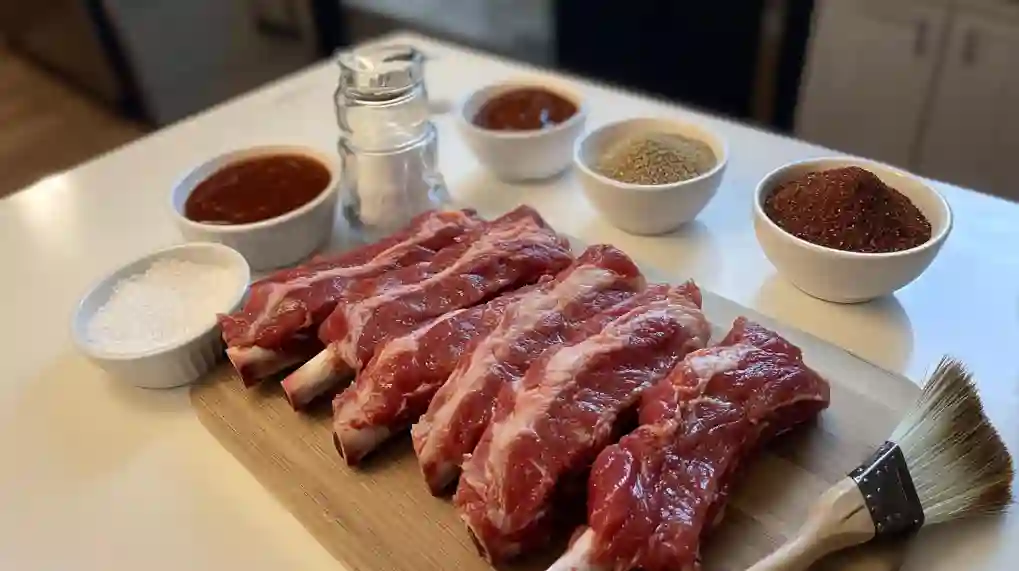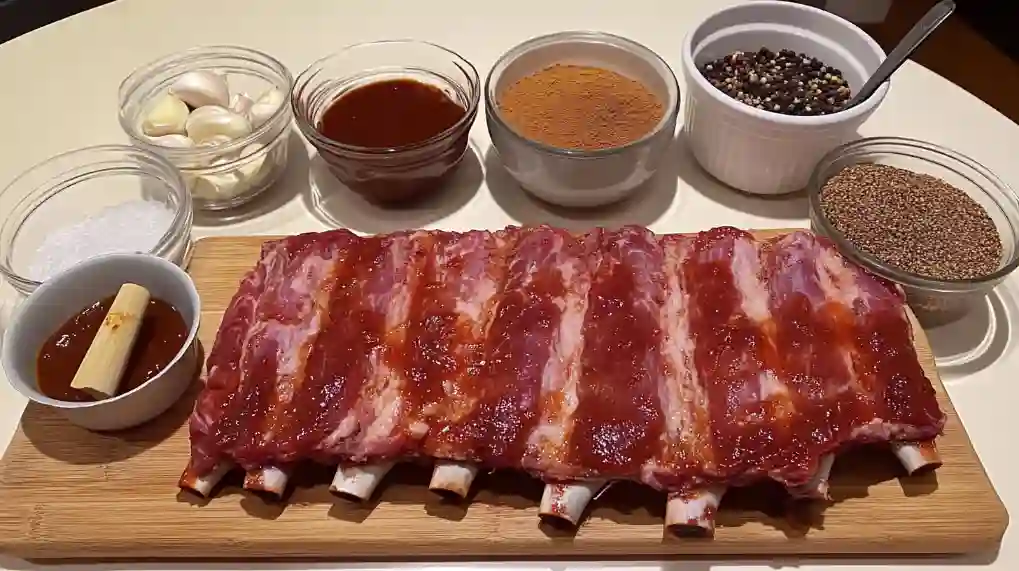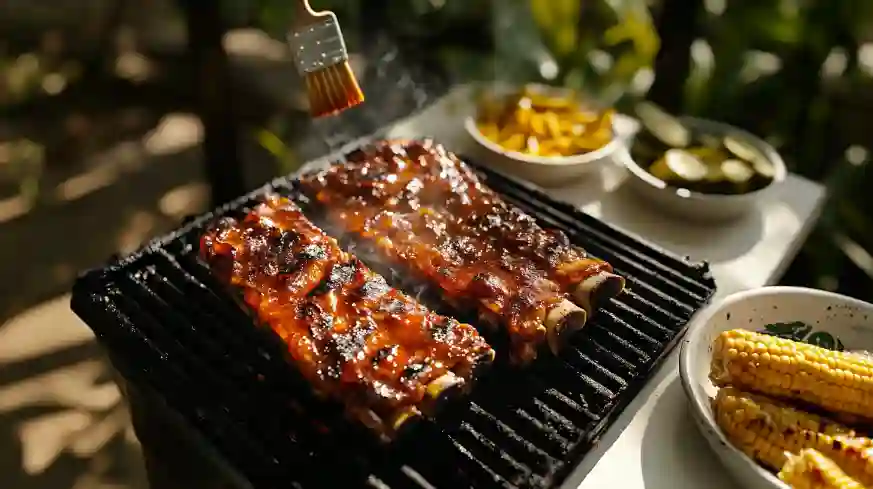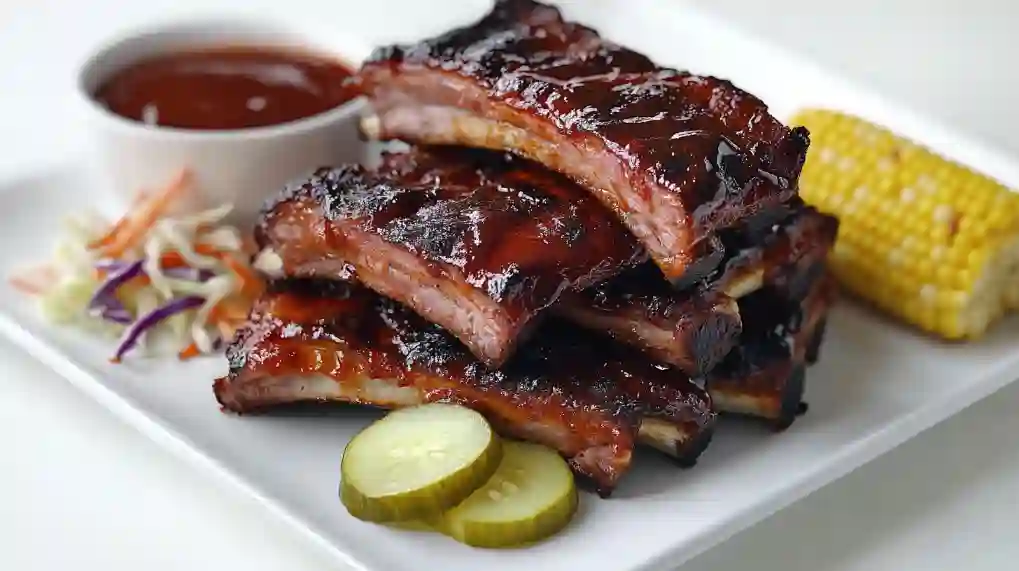One Bite of These Delicious B R and You’ll Be Hooked
There’s something almost primal about the aroma of barbecue ribs sizzling over an open flame — the smoky scent wafting through the air, the rich caramelization of sauce over tender meat, and that first bite that pulls you in with juicy, fall-off-the-bone goodness. Barbecue ribs aren’t just food — they’re a sensory experience, a celebration of flavor, and a beloved ritual that transcends seasons and settings.
Rooted deeply in American Southern culinary traditions, barbecue ribs have long been a centerpiece of backyard cookouts, family gatherings, and regional competitions. From Memphis dry rubs to Kansas City’s sweet and sticky sauces, every corner of the South has its signature style, each telling its own story through spice, smoke, and soul.
I still remember the first time I tasted true Southern barbecue ribs — it was at a roadside shack in Mississippi, where the pitmaster handed me a paper plate stacked with ribs so tender the bones slid right out. That experience sparked a passion that led me to develop my own take on this classic dish — one that honors tradition while adding a personal touch.
This recipe delivers mouthwatering ribs with a perfect smoky flavor, a spice rub that sings with balanced heat, and meat so tender it practically melts in your mouth. Best of all, it’s flexible — whether you’re watching your sodium intake or trying a low-sugar sauce, this recipe can be easily adapted to suit your health goals without sacrificing flavor.
Table of Contents
Ingredients: Building Blocks of Perfect Barbecue Ribs

Crafting unforgettable barbecue ribs starts with choosing quality ingredients that bring out bold, smoky flavors and tender textures. Here’s everything you’ll need to get started:
🥩 The Ribs
- 2 full racks of pork ribs — Baby back ribs are leaner and more tender, ideal for quicker cooking. Spare ribs are meatier and richer, perfect for those who love bold, hearty bites.
- Optional: For a plant-based twist, use meaty alternatives like jackfruit, seitan ribs, or meatless riblets available at specialty stores.
🌶️ Dry Rub (Spice Blend)
- 2 tbsp brown sugar (or coconut sugar for refined sugar-free)
- 1 tbsp smoked paprika
- 1 tbsp chili powder
- 2 tsp garlic powder
- 2 tsp onion powder
- 1 tsp cumin
- 1 tsp black pepper
- 1 tsp salt (use low-sodium if needed)
- ½ tsp cayenne pepper (optional for extra heat)
🥣 Barbecue ribs Sauce
- 1 cup ketchup (look for sugar-free or low-sugar options)
- ¼ cup apple cider vinegar
- ¼ cup brown sugar
- 1 tbsp Worcestershire sauce (gluten-free if needed)
- 1 tsp Dijon mustard
- 1 tsp liquid smoke (optional for added smokiness)
- Salt and pepper to taste
🧂 Optional Flavor Boosters
- 1 tbsp yellow mustard as a base layer before applying the rub
- A splash of pineapple juice or apple juice while cooking for moisture and sweetness
🔍 Ingredient Tips
- Look for ribs with good marbling (fat interspersed in the meat) for maximum tenderness and flavor.
- Fresh, high-quality spices make a world of difference. Toasting whole spices before grinding can elevate the rub.
- For sauces, check labels if you’re gluten-free or reducing sugar — many brands now offer clean versions without additives or corn syrup.
The right ingredients are the foundation of great ribs — flexible, flavorful, and ready to impress.
How to Make Fall-Off-the-Bone Barbecue Ribs: Step-by-Step Instructions
Cooking perfect barbecue ribs may seem intimidating, but once you understand the process, it’s actually a satisfying and even meditative experience. Whether you’re using an oven, grill, or smoker, these steps will walk you through it with confidence — from prepping the meat to that irresistible sticky glaze.
🔪 Step 1: Prep the Ribs
Start with fresh, quality ribs — baby backs or spare ribs depending on your preference. Flip the rack bone-side up and look for the thin, silvery membrane (also called silver skin). This barrier doesn’t break down during cooking and can make ribs chewy, so you’ll want to remove it.
- To remove the membrane, slide a butter knife under one edge near a bone, then grip it with a paper towel and peel it off in one sheet.
- Trim any excess fat or ragged edges to help the ribs cook evenly and avoid flare-ups on the grill.

🧂 Step 2: Apply the Dry Rub
Pat the ribs dry with paper towels. For an extra flavor boost and better spice adhesion, slather a thin layer of yellow mustard over the surface — it won’t affect the taste, but it creates a great base.
Generously coat both sides of the ribs with your dry rub mix, pressing the spices into the meat. Let the ribs marinate for at least 1 hour, or ideally overnight in the fridge. This allows the flavors to deeply penetrate the meat.
🔥 Step 3: Choose Your Cooking Method
Whether you’re working with an oven, a grill, or a smoker, the goal is low and slow heat to break down connective tissue and build deep flavor.
Oven Method
- Preheat oven to 275°F (135°C).
- Wrap the ribs in foil (shiny side in), creating a tight packet. Place on a baking sheet.
- Bake for 2.5 to 3 hours until tender. You can add a little apple juice or broth inside the foil for moisture.
Grill Method (Indirect Heat)
- Preheat grill to 275–300°F (135–150°C).
- Set up two-zone cooking (one side with burners on, the other off).
- Place ribs on the cool side, bone-side down. Close the lid.
- Grill for 3 hours, checking occasionally and rotating if needed.
Smoker Method
- Set smoker to 225°F (107°C) using wood chips like hickory or apple.
- Smoke ribs for 4–5 hours, spritzing with apple cider vinegar every hour to maintain moisture.
🍯 Step 4: Sauce and Caramelize
Once the ribs are tender and nearly done, it’s time to baste.
- Unwrap (if using foil) and brush ribs with your barbecue sauce of choice.
- Return to heat — oven, grill, or smoker — uncovered for 15–20 minutes. The sauce should bubble and thicken slightly, creating that glossy, sticky coating.
For grill or smoker: move ribs over direct heat briefly for light caramelization. Watch closely to avoid burning the sugars.
🧊 Step 5: Rest and Serve
Remove ribs from heat and let them rest for 10–15 minutes before slicing. This step allows the juices to redistribute and keeps the meat moist.
Use a sharp knife to slice between the bones, serve with extra sauce on the side, and get ready for compliments.

🔥 Pro Tips for Rib Mastery
- Avoid overcooking: Ribs should be tender, not mushy. If the bones fall out completely, they may be overdone.
- Use a meat thermometer: Internal temperature should reach around 190–203°F (88–95°C) for optimal tenderness.
- Don’t rush the rest: Skipping the resting time can lead to dry meat and lost flavor.
Tips & Variations: Creative Twists for Every Taste
While classic barbecue ribs are always a hit, there are plenty of ways to customize the recipe to suit different diets and flavor preferences. Here are some fun and flavorful variations to try:
🍖 Diet-Friendly Customizations
- Keto: Keep the recipe low-carb by using a sugar-free barbecue sauce. You can swap the brown sugar in the rub for a keto-friendly sweetener like erythritol or monk fruit. Pair your ribs with cauliflower mash or a crisp green salad for the perfect low-carb meal.
- Paleo: To stay within Paleo guidelines, make sure your barbecue sauce is free from refined sugars, and use coconut sugar or honey as the sweetener. Serve with roasted vegetables or a tangy avocado salad for a satisfying Paleo feast.
- Vegetarian (Jackfruit or Tempeh Ribs): Jackfruit is an excellent meat substitute that mimics the texture of ribs when cooked. Marinate young green jackfruit in your dry rub, grill or bake it until crispy, and top with barbecue sauce for a vegetarian-friendly option. Tempeh also works well — it’s hearty and packed with protein, offering a savory twist when grilled and glazed.
🌶️ Flavor Twists for Unique Ribs
- Asian-Inspired Glaze: Create a savory-sweet glaze using soy sauce, ginger, garlic, and honey or maple syrup. Add a splash of sesame oil for richness and top with sesame seeds and green onions for an Asian BBQ fusion.
- Honey-Garlic Ribs: A sweet and garlicky variation — mix honey, soy sauce, minced garlic, and a dash of chili flakes. Baste your ribs in this luscious glaze and roast until golden and sticky.
- Spicy Chipotle Ribs: For a smoky, spicy twist, add chipotle powder or minced chipotle peppers in adobo sauce to the dry rub. The smoky heat will complement the rich meat, creating a mouthwatering balance.
🍽️ Presentation Ideas
Serve your barbecue ribs with delicious sides that complement the bold flavors:
- Cornbread: Soft, buttery cornbread balances the smoky richness of the ribs.
- Coleslaw: The cool, crunchy texture of a tangy slaw pairs perfectly with warm, savory ribs.
- Loaded Fries: Top crispy fries with melted cheese, bacon, and a drizzle of barbecue sauce for the ultimate indulgence.
🍴 Scaling for Parties and Leftovers
- For a crowd: If you’re hosting a barbecue, consider making extra ribs. The recipe is easy to scale up by multiplying ingredients. If you have a large smoker or grill, you can cook several racks at once.
- Leftovers: Leftover ribs can be shredded and used in tacos, sandwiches, or even added to a rich, hearty stew. For the best taste, store leftover ribs in an airtight container in the fridge for up to 3 days or freeze them for later enjoyment.
With these tips and variations, you can tailor your barbecue ribs to any occasion, diet, or flavor craving. Enjoy experimenting and savoring every bite!
Nutritional Information: Enjoying Barbecue Ribs with a Health-Conscious Twist
Barbecue ribs are often seen as a decadent treat, but with the right ingredients and preparation, they can offer a satisfying, balanced meal. Here’s a breakdown of the nutritional value per serving (assuming a 4-ounce serving of ribs with sauce):
Calories per Serving:
Approximately 350-400 calories (depending on the type of ribs and sauce used)
Protein
- About 25-30g of protein per serving
Ribs are an excellent source of high-quality protein, which is essential for muscle repair, immune function, and overall health. The protein content comes primarily from the meat itself, making ribs a great choice for those looking to increase their protein intake.
Carbohydrates
- 10-15g of carbs per serving (from sauce)
While the meat itself is low in carbs, the barbecue sauce is where the carbohydrates come in. The sugar in the sauce contributes to the carb count, with homemade or sugar-free versions being a healthier choice for those on low-carb or ketogenic diets. For example, using a sugar-free sauce or opting for a homemade glaze with a natural sweetener can reduce the carb content.
Fats
- 25-30g of fat per serving (depending on the cut)
The fat content comes from both the meat and the rub. For a leaner option, baby back ribs tend to have less fat than spare ribs, making them a better choice for those watching their fat intake. The rub, typically made with healthy fats like olive oil or avocado oil, can also contribute small amounts of fat.
Health Benefits of Lean Cuts and Homemade Sauces
Using leaner cuts of ribs, such as baby backs, helps reduce the overall fat content, offering a healthier option without sacrificing flavor. By making your own sauce, you control the amount of sugar, salt, and preservatives, giving you a cleaner and healthier alternative to store-bought versions.
Health Perks of Spices
Certain spices in your dry rub not only enhance flavor but also provide health benefits:
- Paprika is packed with antioxidants, especially capsanthin, which can help combat inflammation.
- Garlic powder contains allicin, known for its heart-healthy properties and ability to support immune function.
These simple spices not only boost flavor but also contribute to overall wellness.
With thoughtful ingredient choices and portion control, you can indulge in barbecue ribs that are both flavorful and nutritionally balanced.

Common Mistakes & Fixes: Perfecting Your Barbecue Ribs
Cooking ribs can be tricky, but with a little knowledge, you can avoid common mistakes and elevate your rib game. Here are some of the most frequent issues and how to fix them:
1. Overcooking or Undercooking the Ribs
- Mistake: Undercooked ribs can be tough and chewy, while overcooked ribs might fall apart and lose flavor.
- Fix: The best way to test doneness is by checking the internal temperature. Ribs should reach 190–203°F (88–95°C) for tender, pull-apart meat. You can also check for doneness by gently twisting a bone — if it starts to pull away from the meat, they’re ready. Another trick is to perform the “bend test”: hold the ribs with tongs, and if they bend slightly and crack without breaking, they’re done.
2. Ribs Turning Out Tough
- Mistake: Tough ribs are usually a result of cooking at too high a temperature or not allowing enough time for the collagen to break down.
- Fix: Low and slow is the key. Cook your ribs at a consistent temperature of 225–300°F (107–150°C) for 2.5–3 hours in the oven or 3–4 hours on the grill or smoker. If your ribs are still tough, try wrapping them in foil and cooking for an additional 30–60 minutes to retain moisture and tenderness.
3. Sauce Burning on the Grill
- Mistake: Applying sauce too early or over high heat can cause it to burn, ruining the sweet, tangy glaze.
- Fix: Apply the sauce toward the end of cooking — about 15–20 minutes before the ribs are finished. This gives the sauce time to caramelize without burning. For grilling, move the ribs to indirect heat for the last part of cooking to prevent direct flames from charring the sauce.
4. Balancing Sweet and Savory Flavors
- Mistake: If your ribs are too salty or too sweet, it can throw off the balance of flavors.
- Fix: If your ribs are too salty, try diluting the sauce with a little vinegar or adding a touch more honey or maple syrup to balance the saltiness. If it’s too sweet, adding a bit of extra acidity — such as lemon juice or apple cider vinegar — can help cut the sweetness and create a more balanced flavor profile.
By keeping these tips in mind and avoiding common mistakes, you’ll be well on your way to mastering perfect barbecue ribs every time!
FAQs: Everything You Need to Know About Barbecue Ribs
1. Can I make barbecue ribs ahead of time?
Yes, you can definitely make barbecue ribs ahead of time! To do so, cook the ribs until they are tender but not completely finished with the sauce. Let them cool and then store them in an airtight container in the fridge for up to 3 days. When ready to serve, reheat and apply the sauce, finishing them off on the grill or in the oven for that delicious caramelized finish.
2. What’s the best way to reheat ribs without drying them out?
The key to reheating ribs without drying them out is to retain moisture. Wrap the ribs in foil and reheat in the oven at 250°F (121°C) for about 20-30 minutes. You can add a splash of apple juice or broth inside the foil to help steam the ribs and keep them juicy. Alternatively, reheat them on a grill over indirect heat, covered, for a few minutes.
3. Can I freeze cooked barbecue ribs?
Yes, you can freeze cooked ribs! After they’ve cooled, wrap them tightly in foil and place them in an airtight container or freezer bag. Ribs can be frozen for up to 3 months. To reheat, thaw overnight in the fridge, then follow the reheating steps above to get them tender and flavorful.
4. How long should I marinate ribs for best flavor?
For optimal flavor, marinate your ribs for at least 1 hour, but ideally overnight. Marinating overnight allows the dry rub to penetrate the meat deeply, giving you richer, more complex flavors. If you’re short on time, even a quick 30-minute marinade can still impart flavor.
5. Can I use store-bought BBQ sauce? Tips for picking a good one?
Yes, store-bought barbecue sauce can be a convenient option! Look for sauces with simple ingredients and minimal added sugars. If you want a cleaner option, check for organic, gluten-free, or sugar-free labels. If you love making it your own, consider adding a touch of extra honey, vinegar, or spices to customize the flavor.
Conclusion: Your Perfect Barbecue Ribs Are Just a Recipe Away!
Whether you’re a seasoned pitmaster or a barbecue newbie, this recipe for barbecue ribs is a must-try. With its perfect balance of smoky flavor, tender texture, and customizable spice rub, these ribs are sure to be a hit at any gathering. The best part? It’s easy to make, and you don’t need a lot of fancy equipment to get that professional-level result.
So, what are you waiting for? Give this recipe a try and let your taste buds experience the magic of truly mouthwatering ribs. We’d love to hear how your version turned out! Share your rib-making adventures in the comments below — or take a snapshot of your masterpiece and tag us on social media using #PerfectRibsAtHome. Let’s spread the BBQ love!
And if you’re hungry for more, check out these crowd-pleasing BBQ recipes: Grilled Corn on the Cob, Homemade BBQ Sauce, and Smoked Chicken. You’re only a few clicks away from your next delicious BBQ feast!


2 thoughts on “Barbecue Ribs”
Comments are closed.